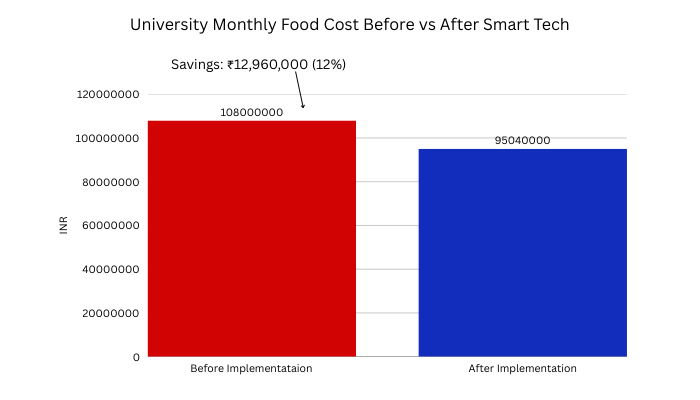Managing food services on a university campus is no small feat-especially when over 12,000 students and staff consume four meals a day. At an average cost of ₹75 per meal, the monthly food expense was staggering-₹1.08 crores. But the real problem wasn’t just cost-it was wastage.
Food was being prepared based on assumptions, not actual presence. On weekends or during events, large volumes of food went untouched. The university wanted a solution that was smart, data-driven, and future-ready.
We implemented a powerful solution by installing Turnstile Gate systems at every entry and exit point, including hostels. Every movement in and out of the campus was now logged, giving real-time visibility into how many students were actually on campus during meal times.
But we didn’t stop there.
We layered the system with AI-powered analytics to study:
12% reduction in food wastage
Monthly cost dropped from ₹ 1.08Cr to ₹95.04Lakhs
₹12.96lakhs saved per month
Planning became smarter and data-driven
Most importantly, the management has now decided to reinvest the savings into:
The 12% cost saving has allowed the university to:
Invest in an automated kitchen
Improve food quality
Enhance student satisfaction and sustainability
If your campus handles thousands of daily meals and you want to improve efficiency, cut costs, and enhance student satisfaction:
Let us help you bring smart efficiency to your compus!

The “Assistance Control” project was inspired by the basic idea of the “Bologna Process”, a Pan-European collaboration which started in 1999, to adapt technology to provide a better quality of education that would allow improvement of the next generation of classroom teaching.
The best project finally chosen and tested involved students registered for classes with NFC phones, during the academic year 2011–2012 at “Universidad Pontificia de Salamanca, Campus Madrid” (UPSAM).
This resulted in the senior students at the School of Computer Engineering to certify 99.5% accuracy and ease of attendance that ensured continuous assessment without loss of instructional time allocated to this activity.
Source : Science Direct Volume 40 Issue 11, 1st September 2013, Pages 4478-4489